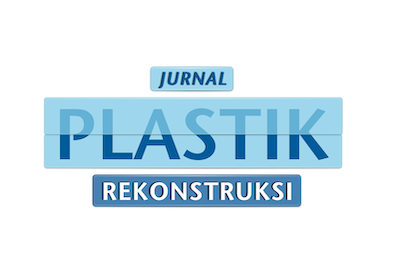Specialty Collaboration in Managing School Age Child with Nasofrontal Meningoencephalocele: A Case Report
DOI:
https://doi.org/10.14228/q3c9ze40Keywords:
Meningoencephalocele, Chula Technique, Plastic Surgery, NeurosurgeryAbstract
Introduction : Meningoencephalocele is one form of neural tube defect that forms a sac containing brain tissue, meninges, and cerebrospinal fluid (CSF). It can cause structural deformities and many other clinical symptoms that come after. Many medical consultations are needed for the case. The collaboration between neurosurgeon and plastic surgeon plays a significant role in managing this case.
Case Report : A case of a 10-year old boy with an apple-size lump in his nasofrontal region, nasal congestion, and central visual field disturbance. The patient has not undergone an examination or surgery in a long time because he lives in a rural area. Radiological results show herniaton brain tissue, meninges, and CSF protruding through the defect in the frontal bone of the cranium that suggest meningoencephalocele as a diagnosis.
Discussion : The definitive management for this case is through surgery. Selecting a surgical technique for meningoencephalocele is essential for optimizing the outcomes and minimizing the risks. The Chula technique approach was chosen for the implementation of this surgery. In this case, we describe the modified Chula technique with stages adjusted according to the patient’s condition. Plastic surgery complements many aspects of reconstruction and restores aesthetic subunits. Managing this case was a challenge until the recovery period. The surgery was successfully performed, and patient went home without any serious complications.
Summary: Caution is necessary in handling surgery and involves aesthetic creativity within it. Long-term monitoring is necessary for post-operative results since many clinical aspects and social developments must be regularly evaluated.
References
1. Matos Cruz AJ, De Jesus O. Encephalocele. [Updated 2023 Sep 4]. In: StatPearls [Internet]. Treasure Island (FL): StatPearls Publishing; 2024 Jan-. Available from: https://www.ncbi.nlm.nih.gov/books/NBK562168/
2. Levene MI, Chervenak FA. Fetal and Neonatal Neurology and Neurosurgery. Elsevier Health Sciences, 2009. p. 233-852
3. Armstrong D, Halliday W, Hawkings C, Takashima S. Pediatric Neuropathology: A Text-Atlas. Springer Science & Business Media, 2008. p. 16-17
4. Buchanan EP. Pediatric Craniofacial Surgery: State of the Craft. Clinics in Plastic Surgery. Elsevier Health Sciences (Internet]. 2019 Apr; 46 (2): 185-198. Available from: http://dx.doi.org/10.1016/s0094-1298 (19) 30003-3
5. Mahatumarat C, Rojvachiranonda N, Taecholarn C. Frontoethmoidal Encephalomeningocele: Surgical Correction by the Chula Technique. Plastic & Reconstructive Surgery [homepage on the Internet] 2003;111(2):556–565. Available from: https://doi.org/10.1097/01.prs.0000040523.57406.94
6. Suryaningtyas, W., Sabudi, I.P.A.W. & Parenrengi, M.A. The extracranial versus intracranial approach In frontoethmoidal encephalocele corrective surgery: a meta-analysis. Neurosurg Rev 45, 125–137 (2022). https://doi.org/10.1007/s10143-021-01582-6
7. Lumintang LM, Niryana IW, Sanjaya H, Hamid AR. Three Years Follow-Up of Single-Stage Correction with Modified Chula Technique for Frontoethmoidal Encephalomeningocele: The Advantage of The Teamwork Approach (A Case Report). Jurnal Plastik Rekonstruksi [homepage on the Internet] 2021;8(2):76–83. Available from: https://doi.org/10.14228/jprjournal.v8i2.324
8. Jeyaraj P. Management of the frontoethmoidal encephalomeningocele. Annals of Maxillofacial Surgery [Internet] 2018;8(1):56. Available from: https://doi.org/10.4103/ams.ams_11_18
9. Holm C, Thu M, Hans A, et al. Extracranial Correction of Frontoethmoidal Meningoencephaloceles: Feasibility and Outcome in 52 Consecutive Cases. Plastic & Reconstructive Surgery [Internet] 2008;121(6):386e–395e. Available from: https://doi.org/10.1097/prs.0b013e318170a78b
10. Hoz SS, Al Ramadan AH, Pople I, Mohammed N, Hamouda WO, El Damaty A, et al., editors. Pediatric Neurosurgery (Internet]. Springer Nature Switzerlan; 2023. Available from: http: //dx.doi.org/10.1007/978-3-031-49573-1

Downloads
Published
Data Availability Statement
This article has not been published on any other platform before.
Issue
Section
License
Copyright (c) 2025 Yunia Tasya Salsabila, Sweety Pribadi, Lutfi Hendriansyah, Graciella Novian Triana Wahjoe Pramono

This work is licensed under a Creative Commons Attribution-NonCommercial-NoDerivatives 4.0 International License.
Authors retain the copyright of the article and grant Jurnal Plastik Rekonstruksi the right of first publication with the work simultaneously licensed under a Creative Commons Attribution License. Articles opting for open access will be immediately available and permanently free for everyone to read, download and share from the time of publication. All open access articles are published under the terms of the Creative Commons Attribution-Non-commercial-NoDerivatives (CC BY-NC-ND) which allows readers to disseminate and reuse the article, as well as share and reuse of the scientific material. It does not permit commercial exploitation or the creation of derivative works without specific permission.













